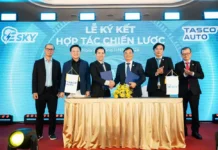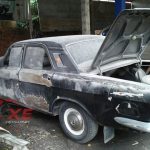In 2023, Mr. Dang Le Nguyen Vu spent billions of VND to bring more than 30 different JDM car models to his garage, and in the early days of 2024, this businessman hit the streets with a unique car model, which may have been purchased last year.

The car we want to mention is the Toyota Corona, a famous model from the Japanese brand. In today’s article, let’s find out and quickly review the extremely rare Toyota Corona of the biggest supercar collector in Vietnam.
In which year was Mr. Dang Le Nguyen Vu’s Toyota Corona produced?
Based on the design details such as headlights, grille, rearview mirrors, and taillights, it is not difficult to guess that the sedan Toyota Corona of the biggest supercar collector in Vietnam is the 3rd generation, which was produced from September 1964 to January 1970 in the Japanese market and from 1966 to 1972 in the Korean market.
Specifically, the 3rd generation of the Toyota Corona series was introduced in September 1964, 1 month before the 1964 Summer Olympics. It was available as a sedan, a hardtop two-door, a wagon, and a five-door sedan. There were also utility coupe variants and a five-door hatchback.

The 40-43 series was dedicated to sedans, while commercial vehicles were in the 46 and 47 series. The hardtop variants received body model codes from 50 to 55, while the five-door hatchback was coded as 56. The 1965 model marked Toyota’s return to the US market after temporarily withdrawing in 1961.
Exterior design of the car
First, we have to mention that Mr. Dang Le Nguyen Vu’s Toyota Corona still has a 4-digit license plate number, which is quite rare. In terms of design, the car has a pair of classic round headlights, placed side by side, on top of a harmonious front grille.



The front bumper of the Toyota Corona 3rd generation protrudes quite far out, originally made of shiny stainless steel, but Mr. Vu’s car is made of black plastic.
Next, the Toyota Corona of the biggest supercar collector in Vietnam is divided into smaller sections, similar to the first version, specifically the model produced in 1966. In this generation, for the first time, the Corona had its own logo on the front grille, first as Toyopet and later as Toyota.

On the side, Mr. Vu’s Toyota Corona has additional orange turn signal lights on the front wheel arches, followed by chrome-plated Corona logos. In addition, the symbol “UN” is added by this businessman using stickers, creating highlights on the white paint.
At the rear, the rear bumper has a similar design to the front bumper, with sharp corners and made of plastic. The turn signal lights, taillights, and reverse lights form a continuous strip. The new logo of the car is placed on the hood.
Interior of the car
Unlike many Toyota Corona models that are currently being sold with severely downgraded interiors, Mr. Dang Le Nguyen Vu’s car has a newly redesigned driver’s cabin and passenger cabin, but the seat color is quite classic.



In general, the car still retains the original details, the owner only added an ashtray and a coffee cup holder, which are two personal items of this businessman.
Other information about the Toyota Corona
Toyota conducted a public demonstration of the performance of the new Corona on the Meishin highway, where the car was tested on a 100,000 km track and could maintain a speed of 140 km/h. Toyota released the Corona one year after its traditional rival, the Nissan Bluebird. In November 1966, Toyota introduced the Corolla, a smaller car to meet the market’s need for a more fuel-efficient vehicle, allowing the Corona to increase in size. The 0-97 km/h acceleration time was 15.1 seconds.
Originally, the commercial models used a 1,198 cc 2P engine with a power of 55 horsepower at 5,000 rpm. This allowed a maximum load of 500 kg for the two-seater version and 300 kg for the five-seater version.

In July 1965, a two-door hardtop coupe was introduced. The top speed of the 1.2-liter Corona was 110 km/h. In January 1967, this car was also offered as a five-door model. In April 1967, larger and more powerful 3P (1.35-liter) and 2R (1.5-liter) engines were introduced, replacing the smaller 2P version in most markets. Their respective powers were 77 and 65 PS.
The Toyota automatic transmission, sold on the market as Toyoglide, was introduced for this Corona model. The 4R engine (12R in Australia) with a capacity of 1587 cc was equipped with dual SU carburetors and had a power of 90 horsepower. Disc brakes were also introduced for the front wheels.
Exporting this Corona model proved to be popular in the US and Europe, with improved engine performance and durability compared to previous versions. In September 1967 alone, Toyota produced 80,000 cars, including 30,000 Corona models.
Soviet Minister’s Car Shines Bright After Rebirth
Over time, especially since the country opened up in the 1990s, Soviet cars have gradually disappeared to be replaced by Japanese, American, and European cars. Many Volga, Lada, and UAZ cars were liquidated from state agencies and transferred to civilian registration, but they did not exist for long before a wave of both imported and assembled cars flooded the streets. Soviet cars slowly drifted away and became a nostalgic reminder of a generation that has gone through two wars.












































